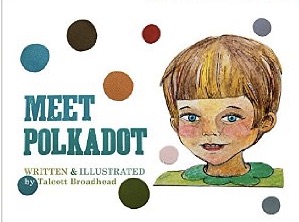Meet Polkadot
Reviewed by Kody Hersh
May 1, 2015
 By Talcott Broadhead. DangerDot Publishing, 2013. 32 pages. $16.99/hardcover; $6.99/eBook. Recommended for ages 6 and up.
By Talcott Broadhead. DangerDot Publishing, 2013. 32 pages. $16.99/hardcover; $6.99/eBook. Recommended for ages 6 and up.
Buy on FJ Amazon Store
As a transgender and genderqueer-identified person, as an advocate, and as someone who works with kids, I’ve been waiting for a book like Meet Polkadot for a long time—a picture book geared toward young readers that affirms the existence and validity of gender identities outside “male” and “female.” When I do education work with adults about trans* (spelled with the asterisk, trans* is an umbrella term meant to include transgender, transsexual, genderqueer, and many other gender non-conforming folks) identities and the gender spectrum, I often feel that I’m fighting an uphill battle against deeply entrenched cultural myths about gender: that gender is dictated by, and synonymous with, a person’s physical sex; that there are only two genders, male and female; that you can tell a person’s gender by looking at them; that women have one kind of body, and men have another. Even folks with a passionate desire to understand trans* experience—including trans* folks ourselves!—have to do a lot of unlearning and reprogramming to really internalize the idea that gender exists in an infinite variety of forms and accept that a person’s gender is what they say it is. Period.
What would happen if instead of these fixed and binary ideas of gender, we grew up with different messages? Talcott Broadhead’s book about Polkadot, a young person who identifies outside the gender binary of male and female, helps me imagine what it might look like to cultivate different understandings of gender in a new generation of children.
Broadhead’s book has many strengths. The artwork is glorious, with rich colors and complex textures that make me want to linger on each page. The message is bold and affirming. The language and concepts presented in the book are thoughtful and current, which is its own feat in a community where language changes rapidly and constantly. The content of the book encourages readers to develop a deeper understanding of not only non-binary gender identity, but also gender in general, and to make connections between gender identity and other social justice issues.
Unfortunately, Meet Polkadot has some glaring flaws as well. The complexity of the language and ideas ranged so widely from one page to another that I had trouble imagining a single child at any developmental stage for whom the whole book would be helpful and appropriate. On too many occasions, overly complex and jargony language is used where simpler concepts would do. Sweet, clear, direct storytelling feels derailed, at times, by a deluge of definitions and explanations.
I don’t think these limitations should keep parents, educators, activists, and others from using Meet Polkadot as a resource for beginning discussions about gender with children. Instead, I think we should use it flexibly: skipping sections if needed; pausing for questions and discussion; making sure we are arming ourselves in advance with the information and language that will allow us to clarify, restate, or expand on the concepts presented in the book. Meet Polkadot shouldn’t be the only resource you, or the children in your life, use to understand non-binary gender identities. Then again, no one book should be. Used in tandem with other resources, Meet Polkadot represents a giant, lovingly executed, step forward.



Comments on Friendsjournal.org may be used in the Forum of the print magazine and may be edited for length and clarity.